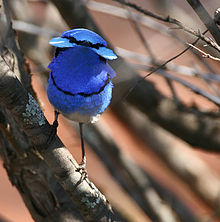Turquoise tail
| Turquoise tail | ||||||||||||
|---|---|---|---|---|---|---|---|---|---|---|---|---|

Turquoise taffeta ( Malurus splendens ), male in splendid dress |
||||||||||||
| Systematics | ||||||||||||
|
||||||||||||
| Scientific name | ||||||||||||
| Malurus splendens | ||||||||||||
| ( Quoy & Gaimard , 1830) |
The turquoise tails ( Malurus splendens ) is a songbird found in Australia from the family of tails (Maluridae). The specific epithet is based on the Latin word splendens meaning 'shiny'.
features
The turquoise tail reaches a body length of 11.5 to 13.5 centimeters and a weight of 8.0 to 11.0 grams. There is a clear sexual dimorphism between the sexes in terms of plumage color . Only the males present during the courtship - a colorful plumage (and breeding season plumage ). With them the crown and throat as well as the belly and back feathers and the long control feathers are colored cobalt blue to azure blue. The wings are blue-green to gray-blue in color. The intensity of the blue coloration can vary greatly from region to region. The neck as well as a chest ring and the eye stripe are black. The turquoise cheeks are striking. Outside of the courtship and breeding season, the males wear a plain dress that is much less conspicuous in color; they then resemble the females, who show a brownish base color all year round, with the breast and stomach area being somewhat lighter. The control springs are gray-blue. The iris is black, legs and feet are gray.
Distribution, subspecies and habitat
The turquoise waffle tail occurs exclusively on the Australian continent. In addition to the nominate form Malurus splendens splendens , which occurs in western and central Australia , three other subspecies are known:
- Malurus splendens callainus Gould , 1867 - from central to southern Australia
- Malurus splendens emmottorum Schodde & Mason , 1999 - in the middle of Queensland
- Malurus splendens melanotus Gould , 1841 - in south Queensland, New South Wales, and northwest Victoria .
The main habitat are arid areas rich in bushes and dry, light eucalyptus forests .
Way of life
The birds feed primarily on insects, including ants (Formicidae), beetles (Coleoptera), grasshoppers (Orthoptera), Schnabelkerfe (Hemiptera), spiders (Araneae) and centipedes (Chilopoda). The food is mostly looked for on the ground, the prey animals being tracked in pairs or in groups of up to eight birds. Swarming termites (Isoptera) are sometimes captured in flight. In order to increase the attractiveness of the females, the males unfold the turquoise cheek feathers in a fan shape during courtship. The breeding season falls from August to January. Turquoise tails live in pairs, but females sometimes mate with several males and make the nest on their own. It has a closed oval shape, has a side entry hole in the upper area, is woven from dry grass and lined with animal hair and feathers. Usually it is placed 30 to 250 centimeters above the ground in a dense bush and provided with two to four eggs, which are hatched in 14 to 15 days. The nestling period is 10 to 13 days. The young are provided with food by the parents and the adult birds of the previous year's brood. The nest predators include red fox , feral domestic cats , house rats , flute birds ( Gymnorhina tibicen ), gray-backed crow's shrike ( Cracticus torquatus ) and laughing jack ( Dacelo novaeguineae ). The red-tailed cuckoo ( Chrysococcyx basalis ) sometimes occurs as a brood parasite .
Danger
The turquoise taffeta is widespread in its areas of occurrence, is considered stable and is therefore classified as ![]() " least concern" by the World Conservation Organization IUCN . In contrast to other easel tail species, however, it does not stay in city parks or gardens.
" least concern" by the World Conservation Organization IUCN . In contrast to other easel tail species, however, it does not stay in city parks or gardens.
Individual evidence
- ↑ a b c d Ian Rowley; Eleanor Russell: Splendid Fairy-wren (Malurus splendens). In: Josep del Hoyo, Andrew Elliott, Jordi Sargatal, David A. Christie, Eduardo de Juana (eds.): Handbook of the Birds of the World Alive. Lynx Edicions, Barcelona 2017 (accessed at http://www.hbw.com/node/59761 on May 2, 2017).
- ^ IOC World Bird List
- ^ IUCN Red List
literature
- Josep del Hoyo , Andrew Elliott, Jordi Sargatal : Handbook of the Birds of the World. Volume 12: Picathartes to Tits and Chickadees. Lynx Edicions, Barcelona 2007, ISBN 978-84-96553-42-2 .
Web links
- Turquoise taffeta (Malurus splendens) in the Encyclopedia of Life . Retrieved August 11, 2017.


